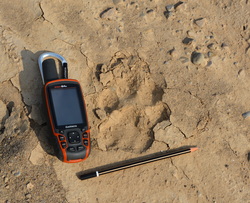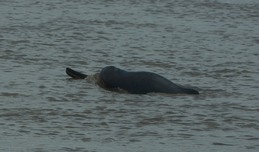Responses of river dolphins to flood induced natural river dynamics and human perturbationsGoal: Investigate how flood induced natural river course change modify the distribution of anthropogenic risks to river dolphins Riverine species are adapted to natural changes in habitats caused by seasonal flood pulses. Abrupt river course changes following intense flooding events interact with and modify socially defined configurations of land and water management (e.g. protected area). Endangered aquatic species thus need to adaptively respond to resulting risk trade-offs after rapid transitions. We investigated the responses of Ganges river dolphin to natural flood-induced habitat change and fisheries in Nepal using field data and long-term hydrological observation at the lower Karnali sub-basin in Nepal. The key highlights of our work are : 1) Natural river channel dynamics modify the distribution of anthropogenic risks to dolphins, 2) Irrigation demands reduce river depth to critical levels even in unregulated rivers of Nepal, 3) Fishing intensity negatively affects small river dolphin populations at low river depths, and 4) Highlights need to balance irrigation demands with ecological flows to conserve river dolphins. |
Supported by:
Tigers in multi-use forests outside protected areas

Goal: Explore the factors that limit or permit habitat use by tigers in multi-use forests
The continuous decline of tiger (Panthera tigris) populations throughout its range and confinement of its breeding populations into few fragmented protected areas typifies the challenges associated with the recovery of depleted tiger populations. Addressing these challenges requires a holistic understanding of influence of different ecological and anthropogenic factors on tiger distribution and the potential of multi-use forests in supporting tiger populations.
My B.Sc. thesis project investigated the potential of multi-use forests in complementing PAs for tiger recovery as a case study from the Western Terai Arc Landscape, Nepal. Specifically, I assessed the influence of key ecological and anthropogenic factors on fine scale occurrence of tiger (habitat use) in three sites (multi-use forests) differing in management regimes (extent of community participation in forest management) with a gradient of protection status, prey availability, human disturbance and trans-boundary connectivity.
Our results show that multiple-use forests with high quality habitat containing higher prey abundance, water resources and grassland patches that provide day time cover and refugia from human disturbance with some form human restriction on use have higher probability of tiger occurrence.
The continuous decline of tiger (Panthera tigris) populations throughout its range and confinement of its breeding populations into few fragmented protected areas typifies the challenges associated with the recovery of depleted tiger populations. Addressing these challenges requires a holistic understanding of influence of different ecological and anthropogenic factors on tiger distribution and the potential of multi-use forests in supporting tiger populations.
My B.Sc. thesis project investigated the potential of multi-use forests in complementing PAs for tiger recovery as a case study from the Western Terai Arc Landscape, Nepal. Specifically, I assessed the influence of key ecological and anthropogenic factors on fine scale occurrence of tiger (habitat use) in three sites (multi-use forests) differing in management regimes (extent of community participation in forest management) with a gradient of protection status, prey availability, human disturbance and trans-boundary connectivity.
Our results show that multiple-use forests with high quality habitat containing higher prey abundance, water resources and grassland patches that provide day time cover and refugia from human disturbance with some form human restriction on use have higher probability of tiger occurrence.
Partial Support by: Hariyo Ban Program/WWF Nepal







